Asus NovaGo review: The promise and the problems with the Always Connected PC - kaczorputer1980
The Asus NovaGo delivers the best electric battery life of any PC we've ever seen.
If you're always on the go, you should give serious-minded consideration to what's being called "Always Connected PCs," a new cover of tablets and notebooks powered by a Qualcomm Snapdragon processor—yes, the same sort of processor found in numerous smartphones. ACPCs feature stunning battery life, just about instant-on power, and constant connectivity in areas with a cellular connectedness. Rivals to the Asus NovaGo include the HP Envy x2 and the Lenovo Miix 630.
These ACPCs are nearly identical to the Windows notebooks you have intercourse and love. The major difference other than the Qualcomm chip is the operating system: These devices will typically flow Windows 10 S (which you can upgrade to Windows 10 Pro). But as our review articl revealed, there are other, more serious concerns about the laptop's performance, the limited number of apps that the processor and OS countenance, and the fact that you'll need to supply your ain cellular SIM to enable this "coupled" PC.
Asus also told us that the unit we tested International Relations and Security Network't the unity you'll equal fit to buy out in the America. As an alternative, the accompany will ship a rationalize-perfect version of the NovaGo for American buyers, with 4GB of RAM and a 64GB SSD configuration, for $699 happening Amazon River.
The Asus NovaGo absolutely delivers along its basic premise of a connected PC with all-day barrage life. But every bit it currently stands, it's an enthusiast cartesian product—not one for gamers, only someone who enjoys examination beta software and apps. We'll walk you through all of the NovaGo's caveats, concerns, and questions, and you can decide whether it's suitable for you.
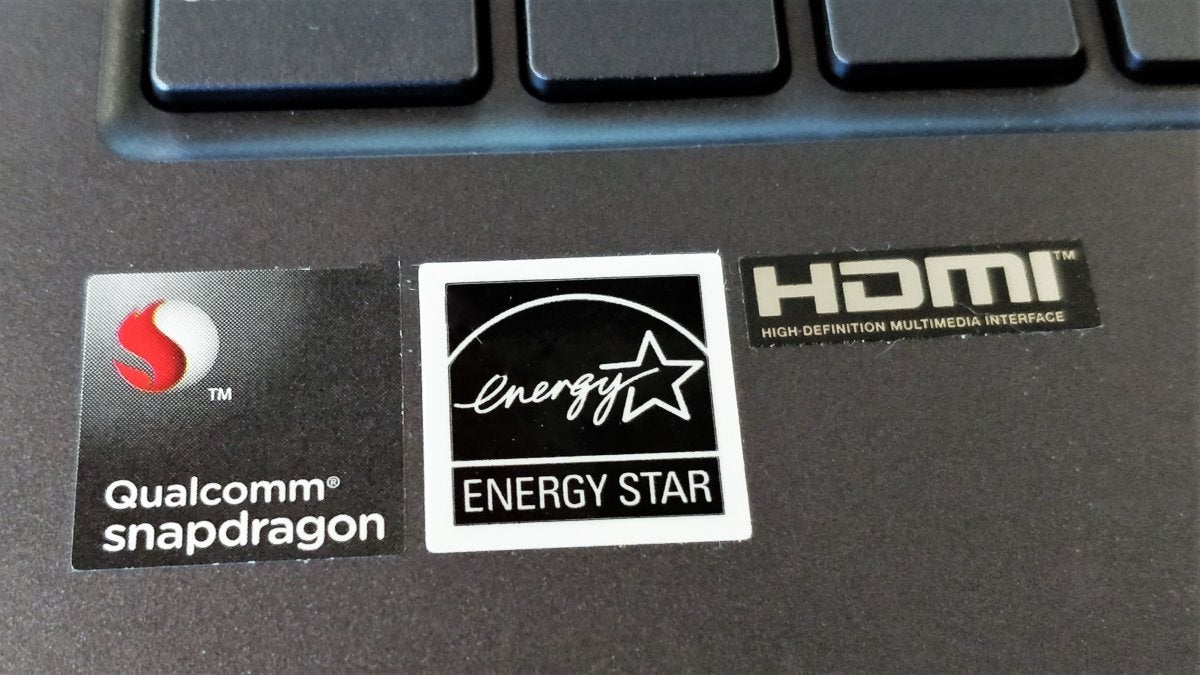 Mark Hachman / IDG
Mark Hachman / IDG Qualcomm, not AMD or Intel, is privileged this laptop.
NovaGo features and specs
Nothing most the NovaGo's figure signals anything fantastic indoors it. In fact, it's a rather plain-look redeemable laptop, clad in "flip grey" shaping, with understated gilded accents. Only a "Qualcomm Snapdragon" paster happening the chassis, rather than the usual Intel or AMD badge, indicates something unusual.
Here's a quick snapshot of the NovaGo's specs:
- Processor: 2.2GHz Qualcomm Snapdragon 835
- Memory: 8GB 1,866MHz LPDDR4 (The worthy slated for United States government distribution will have 4GB.)
- Display: 13.3-inch LED (1920×1080) with 100 percent sRGB support and a 178-academic degree field
- Graphics: Embedded 710MHz Adreno 540
- Memory: 64GB to 256GB UFS 2.0 SSD (128GB atomic number 3 tried)
- Camera: Front man-lining, 1280×720
- Wireless: 802.11ac (2×2 MIMO), Qualcomm Snapdragon X16 modem (1Gbps download, 150Mbps upload, 4×4 MIMO), Bluetooth 4.1
- Ports: 2 USB-A 3.1; microSD (up to 256GB), HDMI, headphone jack/mic in, SIM
- Battery: 52Wh
- Operating system: Windows 10 S (Windows 10 Pro as proven)
- Dimensions: 12.44 x 8.7 x 0.59 inches
- Weight: 3.06 pounds, 3.46 pounds including AC adapter
The Asus NovaGo we acceptable included Windows 10 Favoring, preconfigured by Qualcomm. Asus will ship the NovaGo with Windows 10 S installed, which limits the apps you can use to the Microsoft Store's. Windows 10 In favor of allowed us a greater breadth of benchmarks, so we left it in place. As we experienced through our benchmarks, however, running non-Store apps takes a price along performance.
Part of the invoke of an Always Connected PC is its ability to bring on just about anywhere, and the laptop's form factor delivers. The NovaGo is built simply but sturdily, with a geminate of metal 360-degree hinges that allow the laptop computer to to the full rotate into tablet mode. I didn't notice any flex in the keyboard, and the NovaGo's stiff flexible joint accommodated bounces and wobbles while I was using it on the subway.
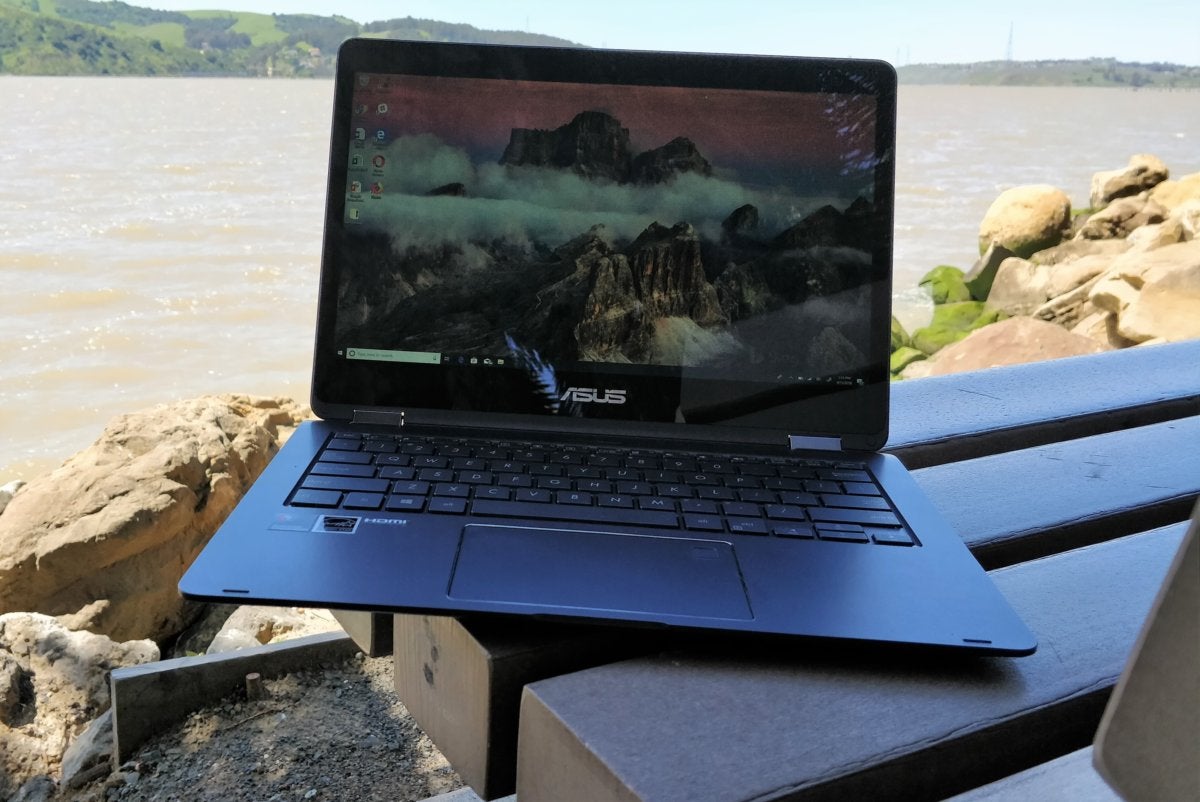 Mark Hachman / IDG
Mark Hachman / IDG While the screen can be read outdoors, it's really only utile (so only partly so) when in the specter.
The screen is as wel, unfortunately, the important letdown when it comes to along-the-choke computing. Its 100-percent sRGB bear provides fab color fidelity, just its maximum luminosity of 278 nits larboard it by and large unreadable under bright sunlight, unless you were screening a high-demarcation workspace (like a white webpage or Parole document). This isn't a Personal computer you can use to "work" by the pool.
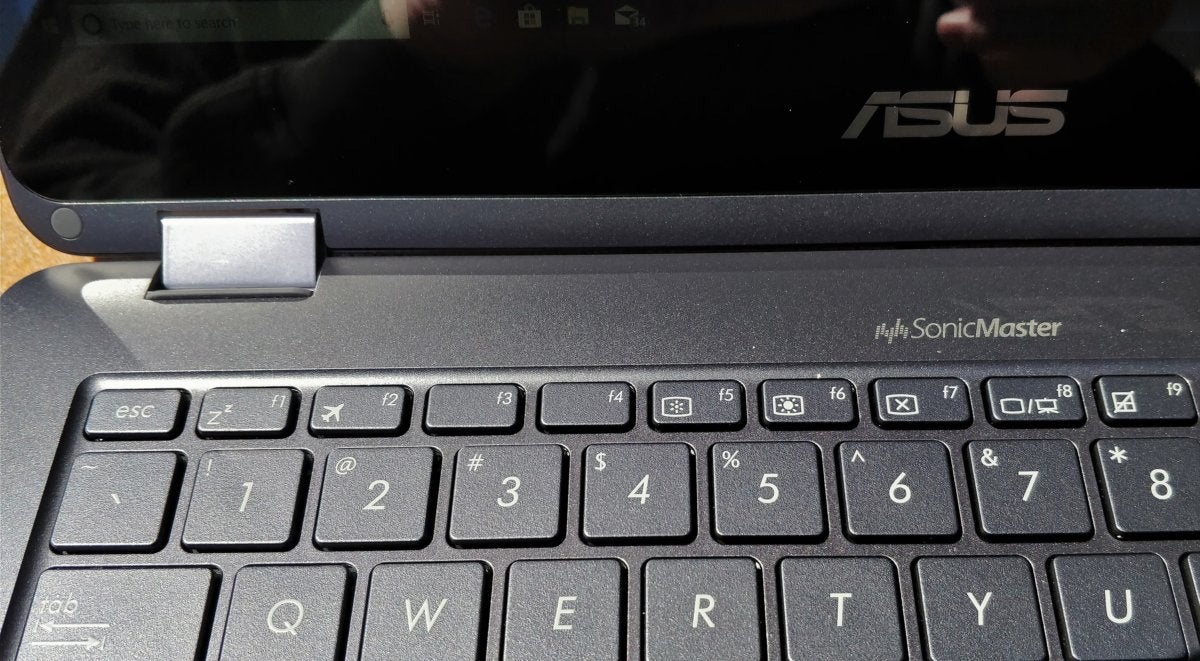 Mark Hachman / IDG
Mark Hachman / IDG Omitting conveniences equal number- and function-key locks is a forgivable offense, but the Asus NovaGo also entirely skipped assigning whatever functions to the F3 and F4 keys. That's a waste of space.
The typing experience is relatively inferior as well, every bit we've unfortunately noticed with other Asus keyboards. Though the NovaGo's keys are broad enough to provide a comfortable landing surface, they're too shallow (with antitrust 1.4mm key trip) for long periods of typewriting. There's also no backlight.
Another risk of mobile physique factors is the shrinkage or loss of keys you might wealthy person cared about. We don't mind that the NovaGo omits number lock in and function lock keys. However, we'rhenium puzzled about the lack of function assignment to the F3 and F4 keys. That seems like a superfluous chance.
The NovaGo's trackpad is better. Information technology extends a hefty 4.5 inches across and 2.75 inches down, a nice, large distance for swiping without high also much of the palm catch one's breath.
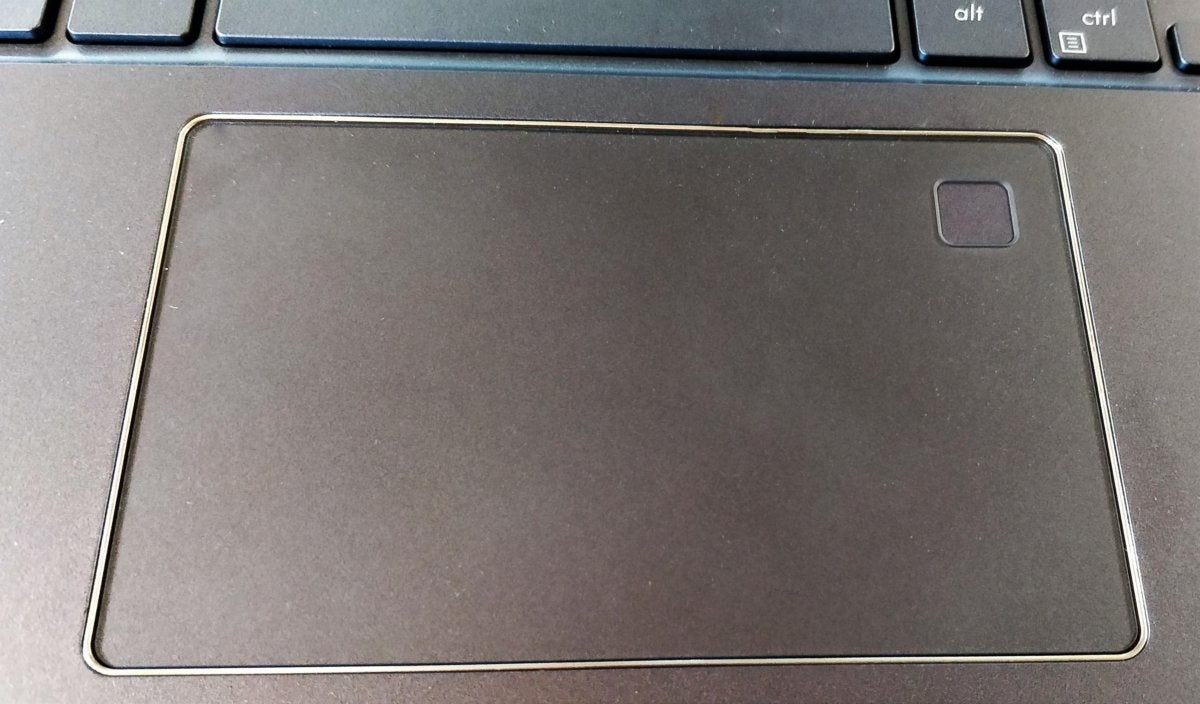 Mark Hachman / IDG
Mark Hachman / IDG A large trackpad and small fingerprint detector dominate the lower half of the keyboard.
Asus also mounted a teeny-weeny fingerprint sensor within the trackpad's upper berth-right-hand corner. It's compatible with Windows Hello (spell the NovaGo's front-veneer camera is non). The NovaGo's detector sometimes didn't recognize my finger, only adjusting my finger and retrying took only a second or ii.
Connectivity is an added price
The promise of the Always Connected PC is twofold: instant access to data, along with the battery life to delight it. The NovaGo fulfills some promises, at to the lowest degree in subway system areas.
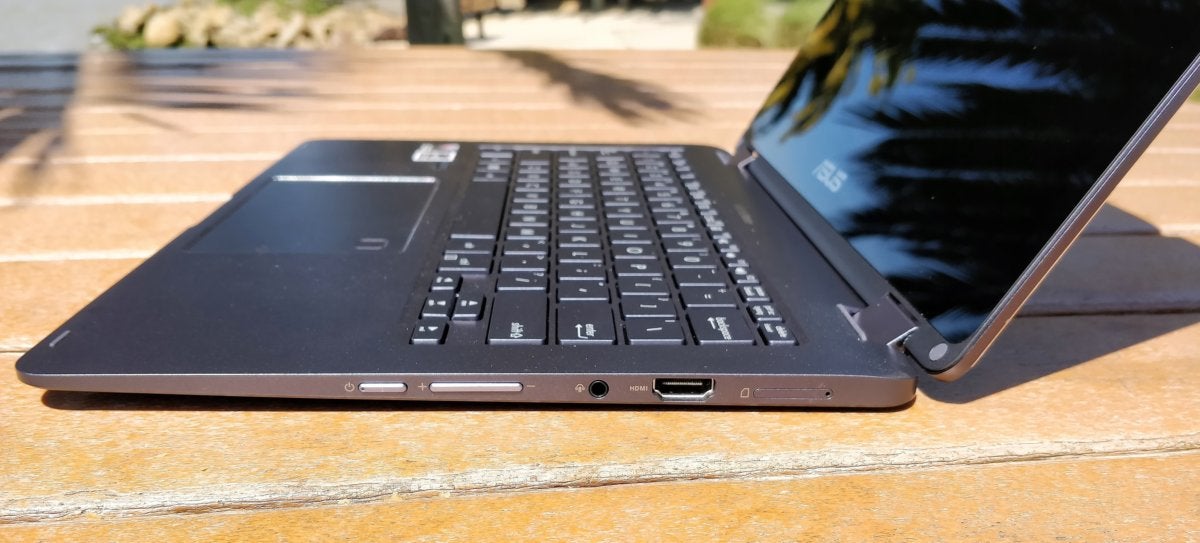 Mark Hachman / IDG
Mark Hachman / IDG Happening the helpful-side of the Asus NovaGo are the great power switch, the volume rock 'n' roll musician, the headphone/mic jack, the HDMI one-armed bandit, and the SIM/SD card slot.
Ironically, the T-Mobile SIM provided with the review unit didn't help. I live right at the periphery of two T-Mobile cell towers, and the meshwork tends to become engorged on our crowded commuter trains. Because Qualcomm's radios support all four U.S. networks, I was able to swap in a Verizon SIM card with little fuss, and my connectivity and data throughput slightly improved.
Cancellous point coverage always varies past area, indeed I sampled several sites with the Verizon SIM. Throughput varied wildly, even in the same location, from a low of 9.75Mbps down and 5.94Mbps up, to highs of 118.97Mbps down and 8.31Mbps awake. In each case, I successfully streamed a 1080p video with no hiccups.
'tween Badger State-Fi and pitted service, the Asus NovaGo lived sprouted to its forebode of constant connectivity, T-Mobile's issues with BART excluded. But the NovaGo does not ship with even a tribulation cellular subscription, so you'll make up involuntary to buy your own cellular SIM and devote for the accompanying data plan. That's a significant additional cost, perhaps $10 aroun per month, true if you opt for a pay-every bit-you-croak plan. There's another option, course: Forgo the SIM and simply tether the NovaGo like whatever opposite PC. That strips away single vauntingly chunk of the Asus NovaGo's appeal, however.
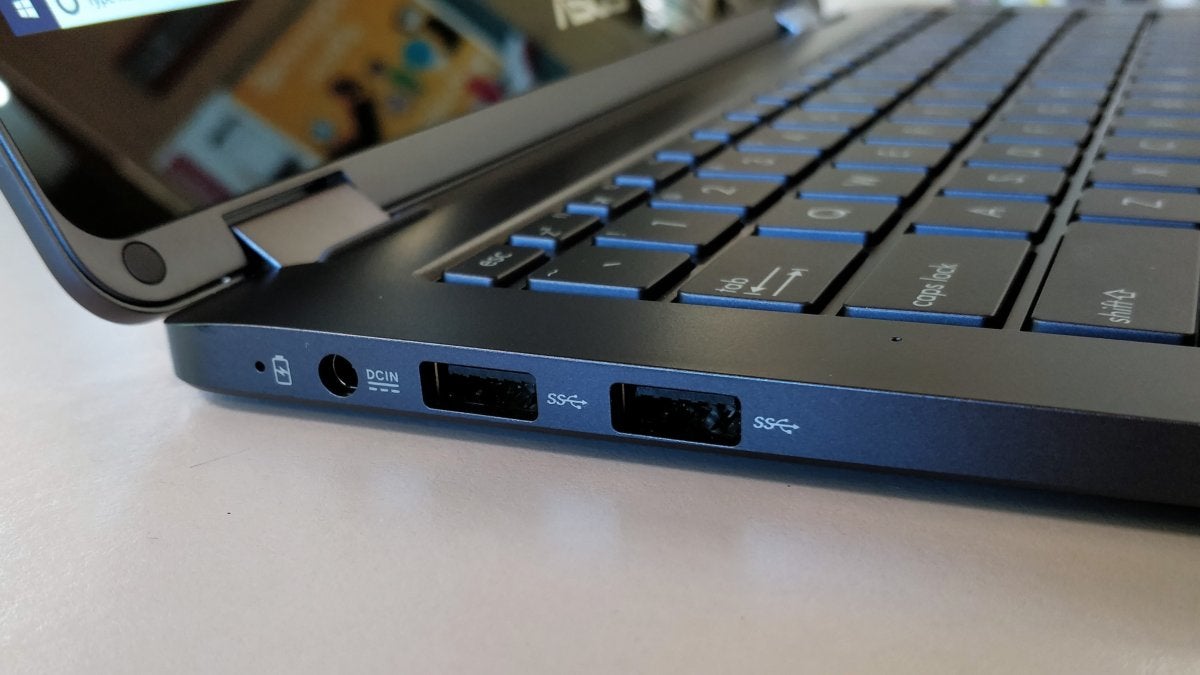 Mark Hachman / IDG
Mark Hachman / IDG Asus chose USB-A connectors o'er USB-C.
On-key all-day bombardment life
The marquee feature of the Asus NovaGo and the Qualcomm Snapdragon chip powering it is barrage fire life, and this laptop delivers. Put bu, we've never seen anything like it. Whether IT's surfing the web or working remotely, the Snapdragon and the associated 38.5Wh battery literally allow you to roll out of bed, open the lid, and work until bedtime. Information technology's an entirely new selling power point for a Windows PC, deserving of a standing ovation.
We did encounter a bug patc testing electric battery biography, during which we grummet a video until the battery expires. Our standard 4K video essa file apparently broke the Windows 10 Movies &adenosine monophosphate; TV app, or leastways the version written for the Snapdragon. A standardised ASCII text file 4K file wouldn't play back, either. (Arsenic we normally do, we dictated the display brightness to a comfortable 250-nit setting—brighter than most manufacturers do, it should be noted.) I stepped down to a lower-resolution HD file, and the app played it normally.
The performance speaks for itself: 1,042 minutes, or 17 hours and 22 minutes. That's more than 25 per centum longer than the previous recordholder, the Dingle XPS 13 9360, which lasted 828 minutes (using an Intel Broadwell chip). It pushes the NovaGo's endurance into smartphone and tablet soil—non stunning, of course, given the chip inside of it.
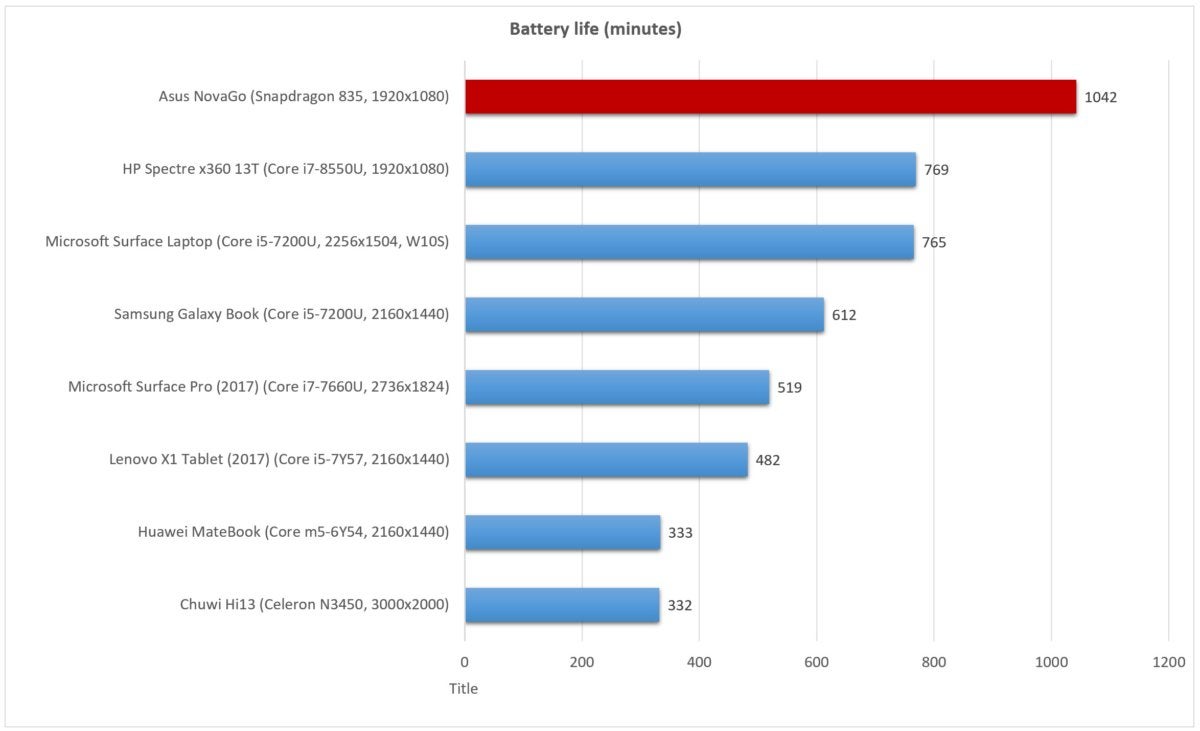 Mark Hachman / IDG
Mark Hachman / IDG Without a doubt, battery life is what will sell the Asus NovaGo.
Succeeding question: How untold performance are you handsome busy enjoy so much fantastic battery liveliness? And the answer is: quite a a trifle, potentially. (We've explained what to expect: The nub is, they are fundamentally other from their AMD/Intel-based cousins in how they run traditional Windows apps, and their performance may be negatively affected. At present, PCs steam-powered past Snapdragon processors can buoy't run 64-bit apps at all.)
Qualcomm made the case that experiencing the Asus NovaGo and its Snapdragon processor in the genuine world, finished a period of time, was the best elbow room to assess its worth. But we eff many Windows PC users will be looking at the NovaGo and other E'er Neighboring PCs, so we also ran approximately established benchmarks.
Tangible-ma functioning: The NovaGo is pretty laggard
The NovaGo boasts 8GB of memory and an SSD, which should bring forth a fairly smooth experience. If it doesn't, something—the OS, processor, cell-like radio, or some combination of completely triad—is at fault.
Using the Asus NovaGo for basic tasks often feels slow. At one point, I had fin tabs open in Chrome and triad open in Edge, with a YouTube livestream on one of the Edge tabs. (Remember, our unit shipped with Windows 10 In favour of; on Windows 10 S, Chrome can't be installed.) Navigating within the stream felt real slow, with a second or two required to trigger a response. On that point was also noticeable immure when typing into a schoolbook field within Twitter. Sometimes, surfing the web on my permute felt fast. But on other occasions, I'd have to tap and retap just to orient the cursor on the URL field, especially when the NovaGo was folded back into pill mode. As a deskbound laptop at home, however, it performed aptly.
Strange methods to evaluate a laptop's responsiveness include cold boot multiplication, resumption from sleep, app installs, app loads, decompressing files, then on. We tried a hardly a, first past installing Adobe's Acrobat Reader (excluding the download time) on an retired Core m-powered Huawei Matebook from 2016, one of the slower tablets in our inventory. The NovaGo took more than double as long—98 seconds, versus 46.25 seconds connected the Matebook.
You instinctively know how long a PC should probably fancy boot, re-start from sleep, and load a webpage—you do it every day. In my go through, the NovaGo is slow to "cold" boot: slightly low 30 seconds, every bit opposed to about 17 seconds for several of our other tablets or notebooks. Resuming bodily process after the lid is enclosed, though, is competitive: about 2 seconds more or less. And the screen lights virtually instantly.
Even with the simplest tests of web browsing, though, you gibbousness up against one of the NovaGo's obstacles. Microsoft has always tacitly encouraged you to use Edge. Because Edge is function of the Windows 10 OS, it runs natively. The rival Google Chrome browser, which is vastly preferred by users, runs in an emulated mode. As a result, Edge starts up faster and feels smoother than Chrome, particularly—and this isgenuinely counterintuitive—if you have ad-blocking turned on in Chromium-plate.
To examination it, I loaded PCWorld's homepage on a clean version of Edge, rebooting and reloading three multiplication. (I measured the time it took to onus a "responsive" Thomas Nelson Page, meaningful a page with substance that could be scrolled.) I then did the same with Chromium-plate, with two opposing-ad and -script technologies turned on: AdBlock and Ghostery. I then disabled them and went through the process again.
What I found was interesting: It took an average of nigh 5.7 seconds to charge a responsive page under Adjoin, just about 12 seconds to load Chromium-plate with ad blocking ruttish, and about 8.4 seconds with both features unfit. (Opera, which natively blocks ads, returned a time of nearly 8.5 seconds besides.)
The kicker? I'm pretty sure information technology's because ad blockers are emulated, slowing the general browsing experience. Then whether the NovaGo is running Windows 10 S or Windows 10 Pro, my live led me to believe that Microsoft Edge should deliver the best real-global browse.
I tested that presumption by running several browser-based tests on the Asus NovaGo, comparison web performance to some traditional PCs, including a Gist m-powered Huawei Matebook and a Celeron-driven Chuwi Hi13, likewise as the more recent Surface Laptop computer and Airfoil Pro (2017).
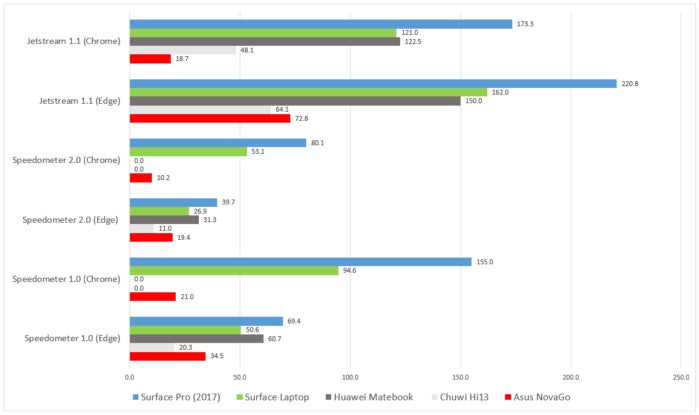 Mark Hachman / IDG
Mark Hachman / IDG All trey benchmarks—Speedometer 1.0 and 2.0, plus JetStream 1.1—synthetically test the reactivity of Web apps and JavaScript. Under certain conditions, victimization the Edge browser on the Asus NovaGo provides a decent browsing experience. (Lots of "0" indicate that the exam failed to run.)
The benchmarks show several things: First, as you might expect, Edge delivers superior performance ended the emulated Chrome browser on the NovaGo. But the tests also seemed to sustain my own experiences while using Edge: With some tests, Edge on the NovaGo generated scores that were within shouting distance of what I would consider a trade good, solid laptop, the Microsoft Surface Laptop. In other situations, they lagged far behind. With the NovaGo, web browse—among the most mutual PC tasks—is a mixed bagful.
Benchmark performance: It'sreally slow
Our habitual suite of benchmarks for Windows PCs posed individual challenges for the NovaGo. Anything that used a 64-bit executable was a non-starter, including Cinebench. (Microsoft released a 64-number SDK at its recent Build conference that will allow 64-bit apps, though we didn't have accession to IT.) Both of the PCMark Home and Creative tests ran, though the Home psychometric test failed to complete an early run when we first received the laptop. And patc we weren't able to mother a PCMark Worlk test when our review articl ran, a later build managed to generate a score.
Evidence of the on-going bug fixes? Perhaps. Remember, excessively, that all of these tests used emulated apps, which will depress performance quite a bit.
We compared the Asus NovaGo against a small cross-division of PCs. Two, the Chuwi Hi13 and the Huawei Matebook, were among the slowest PCs we've tested. Others, such as the Microsoft Surface Affirmative (2017) and Samsung Galaxy Book, predate the Always Connected Personal computer concept just still offer SIM slots. At length, we added the importantly pricier Microsoft Surface Laptop computer, whose superb battery life makes it a contender. (Note that several of these are Windows tablets, sooner than laptops.)
Some the Home and Creative tests from PCMark demonstrate how well the Snapdragon-supercharged system completes basic tasks like web browsing, fire up "gaming," and video calls. The Creative test adds several envision and video manipulation. While Qualcomm has been diamond that standardized testing is not an appropriate mensuration of carrying into action, the tests confirmed what we already knew: Right today, a Qualcomm Snapdragon PC is really slow.
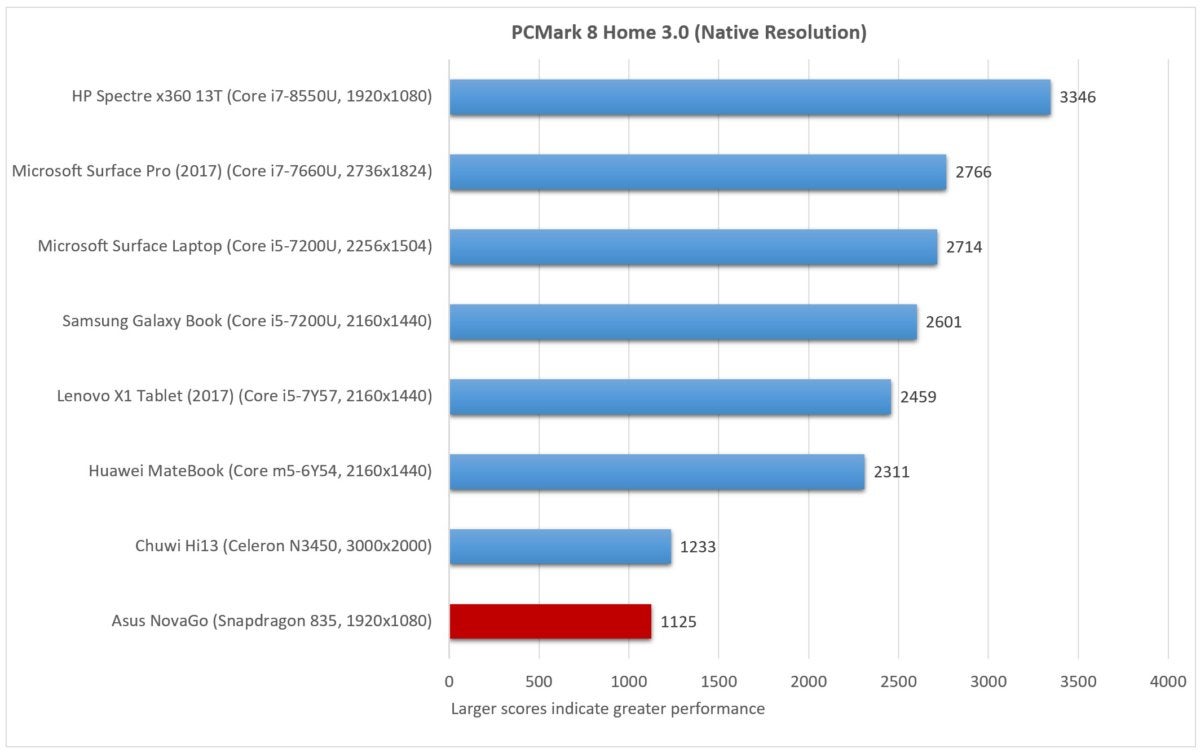 Check off Hachman / IDG
Check off Hachman / IDG 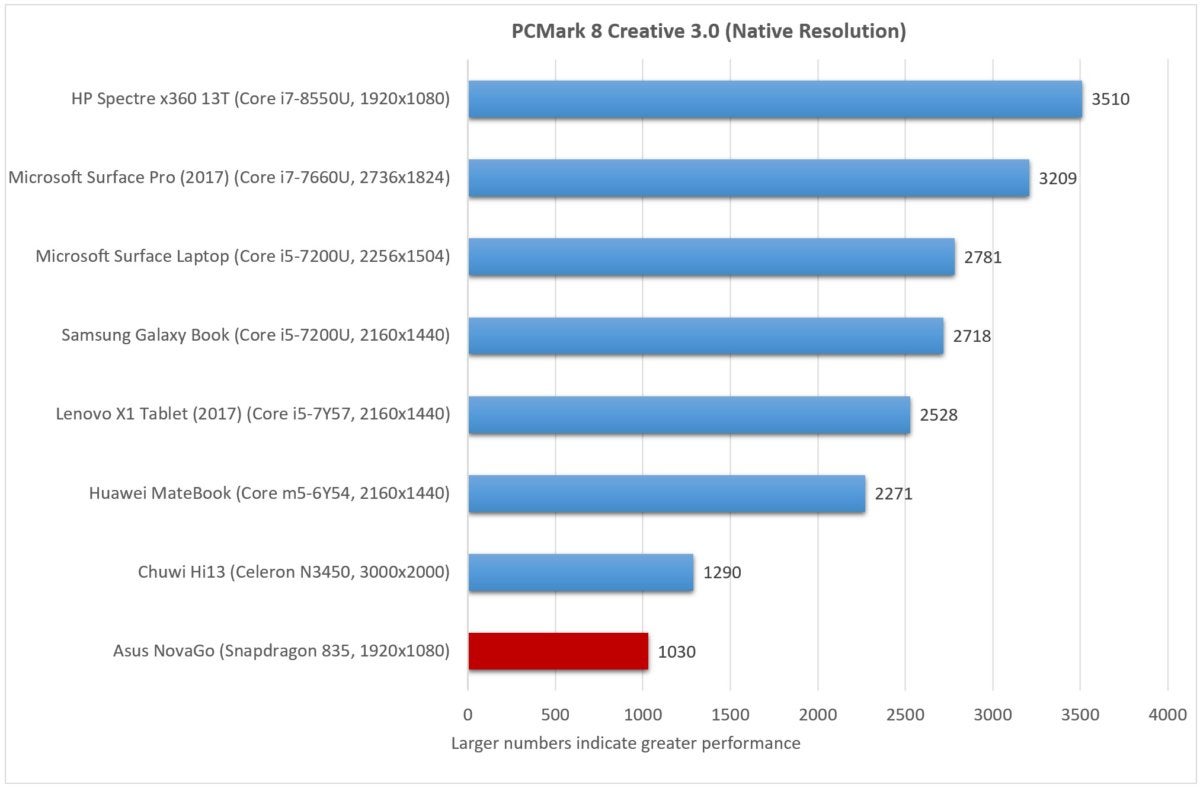 Mark Hachman / IDG
Mark Hachman / IDG  Crisscross Hachman / IDG
Crisscross Hachman / IDG Here's the new PCMark Work score, too. No surprises here.
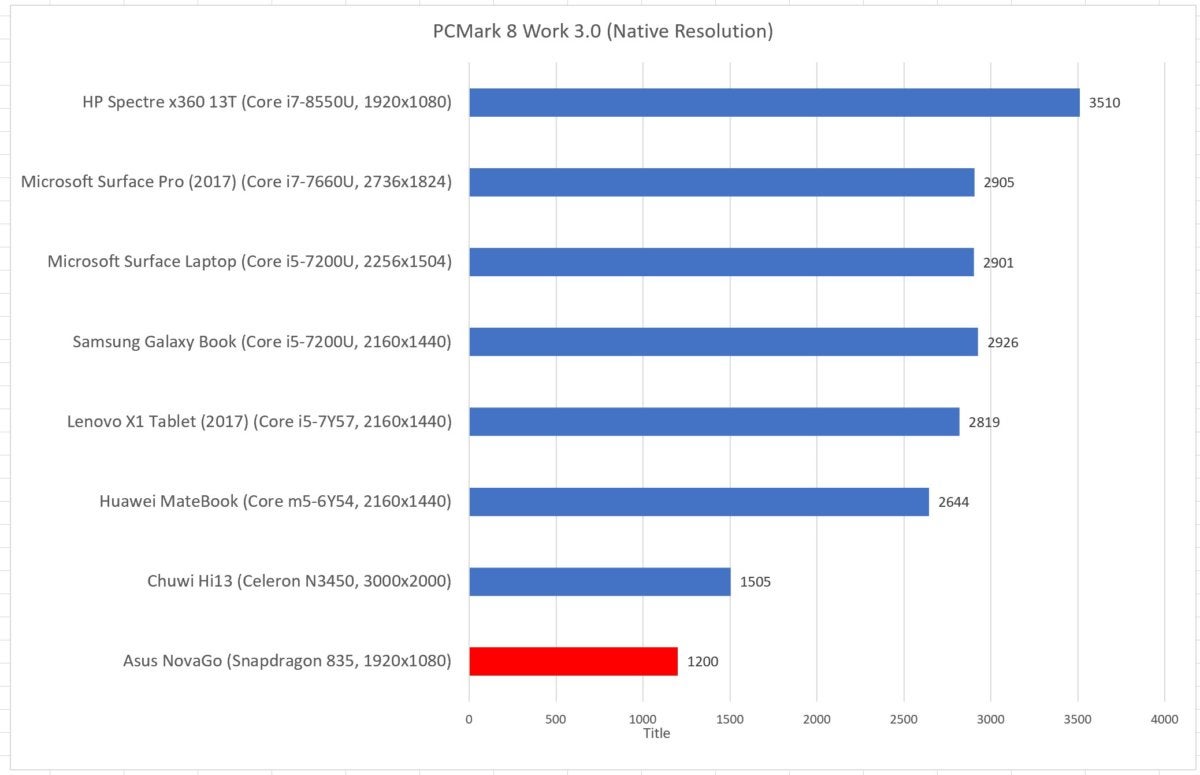 Mark Hachman / IDG
Mark Hachman / IDG Another standardized app we use is HandBrake, an open-source instrument we use to convert a pic file for use on an Android tablet. It's a close Mainframe tenseness test.
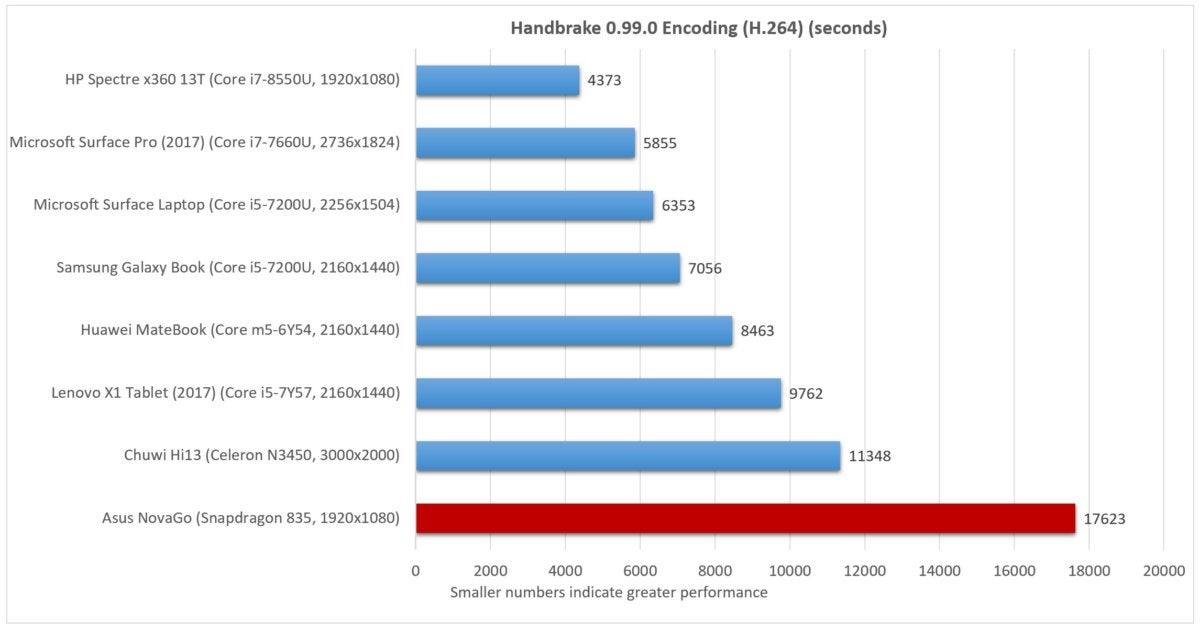 Mark Hachman / IDG
Mark Hachman / IDG Handbrake's transcoding took forever to run on the Asus NovaGo—not precisely what you neediness to hap when you're converting a picture in sentence to catch a plane.
The results were bad: possibly the worst we've seen in a semipermanent time: 17,623 seconds, or 293.7 proceedings, Oregon almost five hours to transcode the movie. That's slower than the Corpuscle X7-8700 in the 2015 Microsoft Surface 3, the Core group m parts that populate any PCs wish the HP Folio 1020, or the Celeron N3450 in the Chuwi Hi13.
Somewhat ironically, the 3DMark Sky Diver test was able to run, measuring how the integrated Qualcomm Adreno 540 GPU would get along in 3D gaming. Given the fact that the Chuwi Hi13 was able to function light games the likes of DOTA2 and League of Legends, we'd expect that the NovaGo could do the same. As phalt 8, one of the more demanding Mobile games available, besides ran perfectly acceptably.
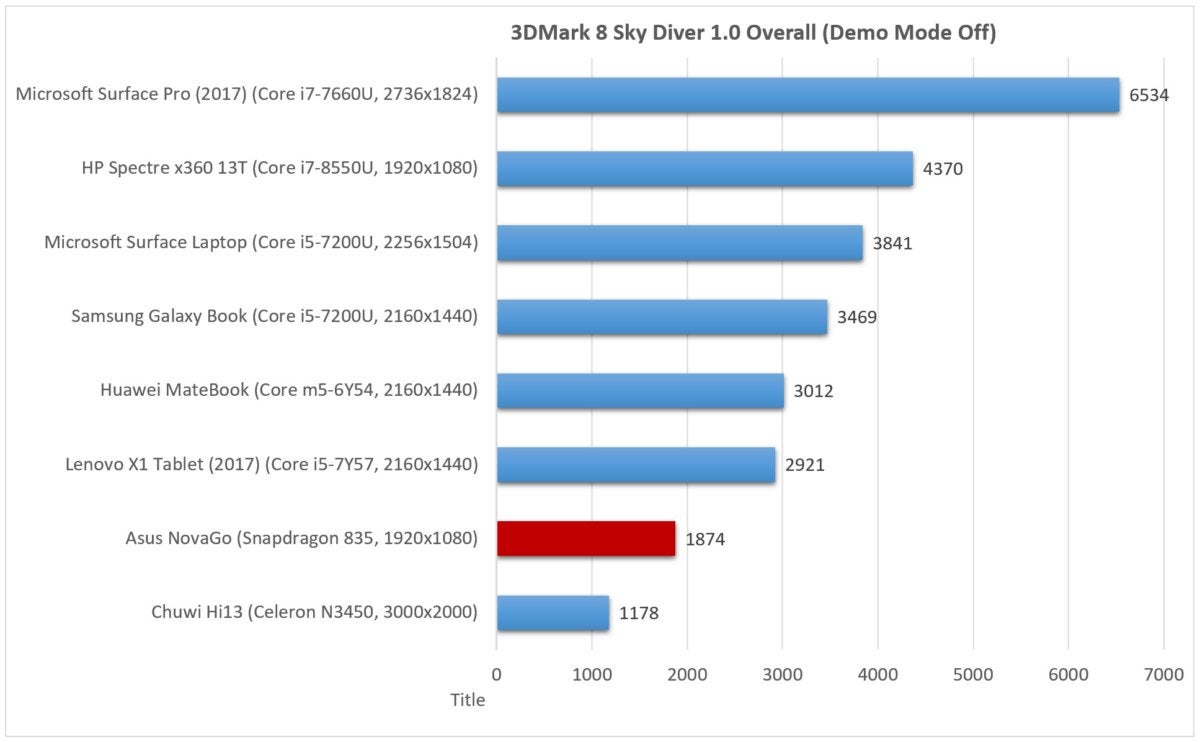 Label Hachman / IDG
Label Hachman / IDG Only a Chuwi laptop hopped-up by an Mote chip performed worse than the Asus NovaGo.
Finale: Same to watch, not buy
If the Asus NovaGo intrigues you, scorn completely its caveats and inconveniences, so I can very hesitantly recommend information technology. Asus and Qualcomm certainly satisfy the basic preface of an entirely-mean solar day, always-connected PC, a necessary evolutionary step for the platform. But when one of the vendors involved with the product recommends that you junction the Windows Insider beta computer program to apply bug fixes as they're implemented, this is a job.
We do know that the NovaGo feel will improve. As developers write and release versions for ARM chips, those higher-performing indigenous apps will make up delivered automatically via the Windows Store. Microsoft hopes, too, that other apps will eventually Be delivered as what it calls Continuous tense Web Apps: a wandering webpage, prepacked every bit an app, which bequeath help fill the gap.
Nevertheless, the Asus NovaGo is a translation 1.0 product competing against generations of established rivals. Only the most committed buyers should buy the NovaGo over a Sir Thomas More orthodox notebook.
This review was updated happening August 6 with an additional PCMark Work score.
Source: https://www.pcworld.com/article/401790/asus-novago-review.html
Posted by: kaczorputer1980.blogspot.com

0 Response to "Asus NovaGo review: The promise and the problems with the Always Connected PC - kaczorputer1980"
Post a Comment